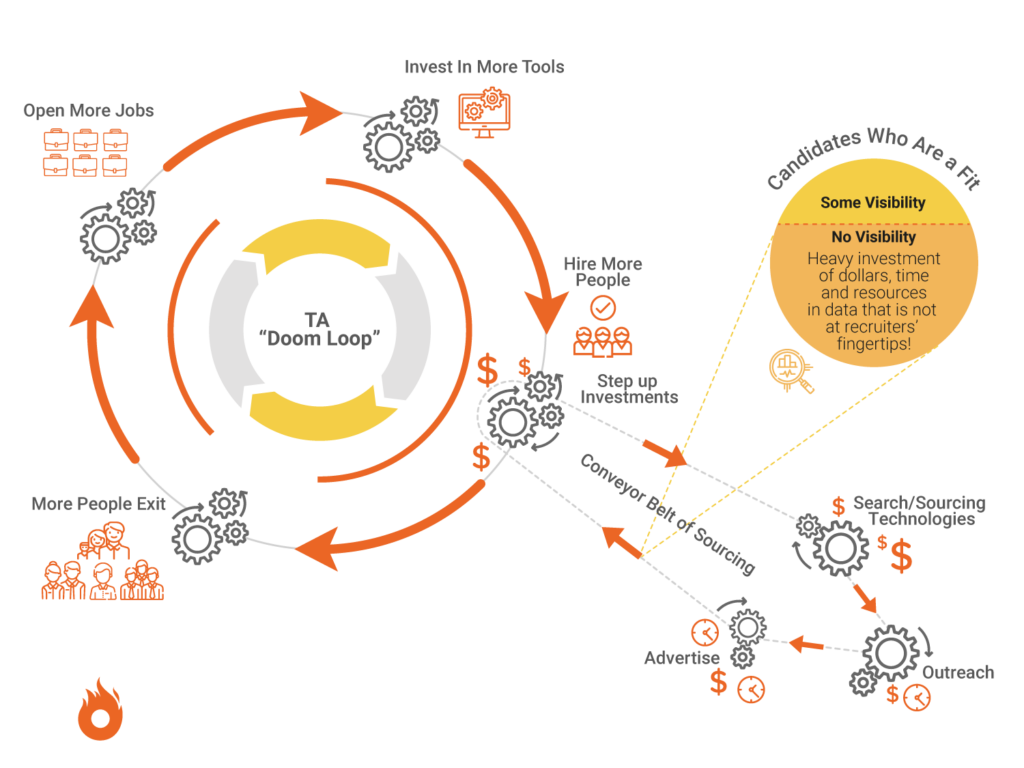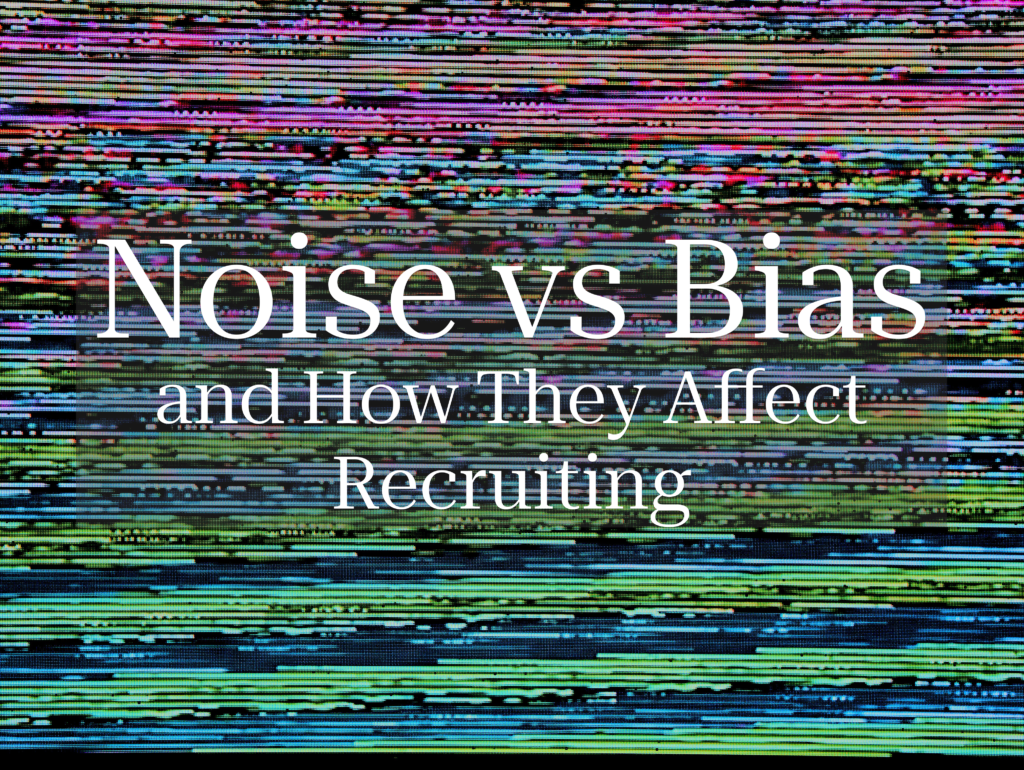When Rich Post, our Chief Revenue Officer at MojoHire, started his role with Team Mojo, he described to us a market observation he termed the Doom Loop. (Somewhat fatalistic, Rich!) Despite the fatalism, it resonated with everyone. As Rich described the Doom Loop as a wheel of momentum driven by external market factors that made talent acquisition teams’ working lives more and more difficult.
The more we’ve thought about the Doom Loop – in addition to some broader forces in HR tech – the more we realized that a major pattern has started to emerge in the world of talent acquisition. This pattern has confirmed one of the main reasons MojoHire exists, and why we are so excited about our technology. In this article, we explain how the Doom Loop plays out and how people in talent-focused organizations can best respond to these changes. The good news is, there is a way to escape the Doom Loop and attract and retain top talent, even in today’s challenging environment.
The Doom Loop
The Doom Loop is an emergent business process cycle that is forcing talent acquisition (TA) teams to perform more repetitive, tactical work.
It has three self-perpetuating cycles:
Cycle 1: The external environment takes control
Cycle 2: TA fights back: Systems and tools investment
Cycle 3: A Pareto distribution forms and great candidates get overlooked
Cycle 1: The external environment takes control of talent acquisition
Some degree of employee turnover is to be expected, but recent external forces have accelerated this trend to unprecedented levels (a phenomenon referred to as The Great Reassessment). People are leaving companies in droves to pursue other opportunities – both inside and outside of work. As more people leave, the TA team opens even more job reqs. In turn, this pushes recruiters to make more hires. As they start to hire more people, they feel like they don’t have the resources, and they double down on investing in more tools. (All glaringly obvious so far.)

Cycle 2: TA fights back: Systems and tools investment
To meet increasingly challenging targets, TA teams step up their investment in systems and tools. They pick HR tech from the endless stream of options being launched onto the market. With these investments, the main aim is usually to increase the amount of information running through tools along what we call the “conveyor belt of sourcing.” This conveyor belt is typically built around the automation of three core functions:
1. Search (the ability to find more new people)
2. Outreach (the ability to contact more new people)
3. Advertising (letting potential candidates know that your req exists)
These investments significantly increase the number of candidates in organizations’ applicant tracking systems (ATS), candidate relationship management (CRM) systems, sourcing systems and even human resource information systems (HRIS). At the same time, however, this influx of new data creates challenges of its own.

Cycle 3: A Pareto distribution forms and great candidates get overlooked
Following some heavy investment, spirits pick up and the team gets flooded with new people and data. But, alas, despite this flood of new data, recruiters still don’t discover enough suitable candidates.

Unbeknownst to teams, the rapid influx of new data has created a Pareto distribution for visibility to great candidates. (As a reminder, the Pareto distribution, aka the 80-20 rule, is the widely observable phenomenon whereby 80% of the outcomes are attributable to 20% of the causes).
The Pareto distribution looks like this:

Your recruiting team only gets visibility to approximately 20% of the candidates that are a fit for the roles they recruit for. The remaining 80% of candidates remain undiscovered in disparate systems within the HR tech stack. This problem is not a new business problem, but has been dramatically amplified by several trends:
Increased data volume: Due to the swarm of people who are now looking for new opportunities, the sheer number of candidates applying for roles increases. Your team runs out of time to screen them all.
Most HR tech stacks are broken: HR technology stacks (particularly older technologies) are built in silos, with poor integration capabilities, poor user experience and designed based on a command-and-control mindset (even the term “applicant tracking system” implies that organizations have some sort of surveillance capability).
Recruiters now typically spend most of their time screening unqualified candidates: The increased number of candidates available to recruiters via the “conveyor belt of sourcing” causes recruiting teams to spend valuable time (studies show up to 30 hours per week) screening less suitable candidates.
Increased data mismatches: Sourcing and search technologies have significantly lowered barriers to entry for a candidate to apply for a role, requiring less knowledge of the requirements for that role, and – generally – less energy to apply. They may still be great candidates, but on the whole, they are putting less thought behind the roles they are applying for, because it’s easier to let sourcing tools do the work.
Less focus on the data that matters: Most popular search and sourcing tools focus on data extraction and the matching of job titles and roles, and far less on an intelligent understanding of more complex concepts like experience and skills. As a result, people in your organization’s ecosystem who may be qualified for a role they didn’t apply for directly, or who don’t have the “right” keywords in their resume, don’t get discovered at all.
What a bind! You have invested time and money to get these candidates into your ecosystem, you have more data than ever, but this flood of new data causes most of the great candidates you have already invested in to get completely overlooked. The data distributions we see are very close to what Mr. Pareto himself saw! See below:

How to escape the Doom Loop
Conquering the Doom Loop requires team effort from C-level leadership and talent acquisition teams, as well as support from HR and hiring managers. Here are some concrete steps you can take:
1. Build business processes that empower recruiters to think strategically
Organizations must continue to build business processes that encourage (and reward) recruiters to take time to think about how effective they are day to day. We’ve seen daily stand-up structures work well. In this scenario, recruiting teams meet daily to address their value-add each day.
2. Use AI to do some of the heavy lifting
Empowering your recruiting team requires investment in software that automates non-value-added tasks like reviewing unqualified candidates. For each open req, you may get hundreds or thousands of applicants, but will only hire one person. An AI and automation solution like MojoHire can intelligently scan mass volumes of candidate data like a seasoned recruiter and instantly surface only the best-fit people you can contact right away. MojoHire’s smart parsing engine “understands” the candidate journeys, skillsets and even behavioral and cultural qualities that go into determining whether they are a good fit. This functionality alone has slashed the time from posting an open req to discovering the first qualified candidate by more than 90%.
3. Break down data silos
Sourcing tools offer great insights, but the Googlization of recruiting has caused recruiters to overlook two key pools of people:
a. Those who currently work at the organization
b. Those have previously applied for a different role
MojoHire is a technology-agnostic solution that sits on top of any existing HR tech stack and is able to analyze data from any number of different data repositories, so that no qualified candidate goes overlooked – even if they didn’t apply for that position or are already working at the company
4. Assess your ATS for its ability to detect active candidates
One of the main drivers of the overlooked candidate problem is the fact that people who have previously applied for jobs in your organization are overlooked for new reqs that come up. As mentioned previously, part of this is because keyword-based searches might not pull up candidates that applied for a different role, because the search terms might be different. The other common issue is that these databases are notorious for having a ridiculously clunky user interface (UI). Many recruiters would rather spend all day on LinkedIn than drive themselves crazy trying to mine their ATS.
MojoHire solves this problem by providing a unified interface that mines all of your data repositories, so you have one, simple, ergonomic platform for instantly and intelligently discovering the best-fit candidates, no matter where their data might be stored.
There is an escape!
The Doom Loop has a strong pull, but artificial intelligence and automation, as well as unifying different HR systems, provide a way of escape. MojoHire was built for such as time as this. Contact us at info@fastr.ai to find out how your talent acquisition teams can conquer the Doom Loop.
[elementor-template id=”1304″]







